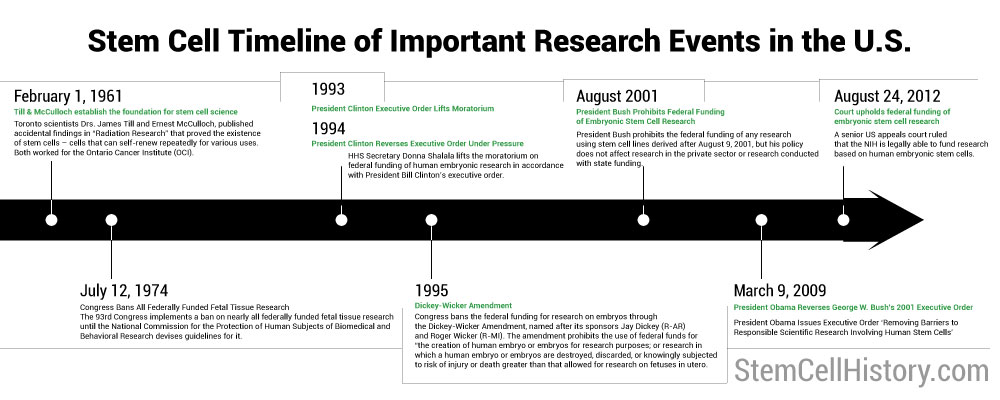Stem Cell History | Exploring the Roots of Regenerative Medicine
The information used to compile this Stem Cell Research Timeline comes from many different sources, including the National Institutes of Health. A useful list of links to other stem cell research timelines from around the Web can be found at the bottom of this page.
Though there was some evidence of stem cells or ‘special cells’ able to produce other cells as early as the late 1800s, this timeline begins in 1961 with the first published study that accidentally identified cells that are able to renew indefinitely for a variety of uses.

February 1, 1961:
Till & McCulloch establish the foundation for stem cell science.
- Toronto scientists Drs. James Till, a biophysicist, and Ernest McCulloch, a haematologist, published accidental findings in "Radiation Research" that proved the existence of stem cells - cells that can self-renew repeatedly for various uses. Both worked for the Ontario Cancer Institute (OCI) at the time.
July 12, 1974:
Congress Bans All Federally Funded Fetal Tissue Research
- The 93rd Congress implements a ban on nearly all federally funded fetal tissue research until the National Commission for the Protection of Human Subjects of Biomedical and Behavioral Research devises guidelines for it.
July 12, 1974:
National Commission for the Protection of Human Subjects of Biomedical and Behavioral Research
- The National Research Act established the National Commission for the Protection of Human Subjects of Biomedical and Behavioral Research within the Department of Health, Education, and Welfare to define policy for protection of human subjects during medical and/or scientific experiments.
1975:
Ethics Advisory Board Established
- Guidelines establish an Ethics Advisory Board for fetal and fetal tissue research that originate from abortions.
1980:
President Reagan Kills Ethics Advisory Board
- President Ronald Reagan decides not to renew the Ethics Advisory Board's charter. The EAB had recommended federally funded investigations into the safety of in vitro fertilization using human embryos developed in vitro for no more than 14 days, but a de facto moratorium halts federal funding of human embryo research due to the EAB's disbanding.
1988:
Federal Panel Approves Funding of Embryo Research
- Human Fetal Tissue Transplantation Research Panel reopens the question and votes 18-3 to approve the federal funding of embryo research. Despite this level of support for the research, the Department of Health and Human Services accepts the testimony of three conservative dissenters who argue that embryonic research would lead to an increase in abortions, and in response, extends the moratorium on this research.
1990:
President George H.W. Bush Vetos Bill Lifting Moratorium
- Congress attempts to override the moratorium through legislation but President George H.W. Bush vetoes the measure.
1993:
President Clinton Executive Order Lifts Moratorium
- HHS Secretary Donna Shalala lifts the moratorium on federal funding of human embryonic research in accordance with President Bill Clinton's executive order.
1994:
President Clinton Reverses Order
- A National Institutes of Health human embryonic researcher panel supports the research but thousands of letters urge President Clinton to reverse his earlier decision. He agrees and federal funding of embryonic research is halted.